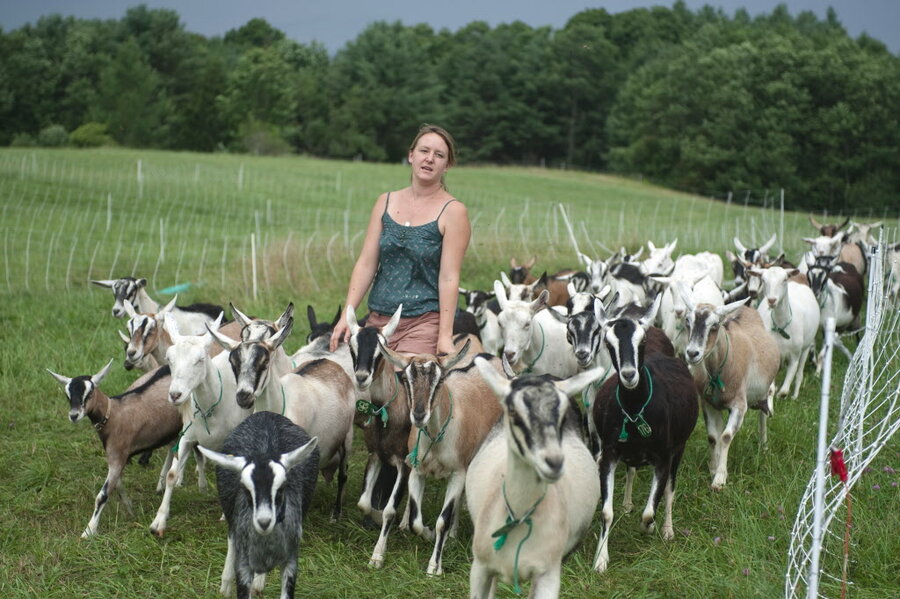The rise of independent cheesemakers
Loading...
Note to Stir It Up! readers: This is an article from the Massachusetts Institute of Technology (MIT) about a new book that delves into the state of artisnal cheesemakers in the United States. I found it interesting, as it reflects culinary themes and trends that we have explored at CSMonitor.com, and I trust that you will find it informative, too.
Crafting high-quality artisanal cheese is not complicated, but it’s also not easy. Basically, heat a lot of milk, add bacterial cultures and enzymes to thicken it into a curd, drain it, salt it, and let it ferment and age. Of course, to make cheese like this, you must first buy fresh milk or own a farm and stock it with cows or sheep or goats plus equipment, and spend endless strenuous hours carrying around heavy pails and obsessively cleaning equipment to make sure it’s sanitary. Do this day after day, until you have enough cheese to distribute, market and sell in a crowded marketplace. Then repeat the whole process.
Does this sound like a job you would enjoy? For a growing subculture of Americans, it does: The number of independent cheesemakers in the United States has doubled since 2000. Some of these people are rebelling against what they see as an overly corporatized, factory-scale system of food production in America. Others are trying to preserve local landscapes, jobs, and a traditional way of life.
But for all the stress and strain of running a farm and selling a product, artisanal cheesemakers represent a new version of an old American dream: people who make a living doing what they want, where they want, on their own land.
“They get life out of it,” says Heather Paxson, an associate professor of anthropology at MIT, who has spent years studying artisanal cheesemakers. “They find joy in the alchemy of working with this fluid substance that becomes something glorious, and they don’t get tired of it.”
Now Ms. Paxson has turned her research into a new book, “The Life of Cheese” – published in December 2012 by the University of California Press – which delves into the ethos, methods and politics of artisanal cheese-making. At a time when the ethics of food is an important issue for many Americans, the work offers a unique glimpse of people who have taken foodmaking into their own hands.
A sense of where you are
The roots of America’s current artisanal cheese movement date to the back-to-the-land movement of the 1970s. Many of today’s cheese artisans, Paxson found, are well-educated former white-collar workers who either burned out in their previous jobs or are living a long-held dream of farming, often in a place that is meaningful to them. “They love where they live,” Paxson says.
Take, for instance, Vermont Shepherd cheese, made in Putney, Vt., and run by a Harvard University graduate, David Major, who sees cheesemaking as a way of keeping his family’s property intact and of remaining “directly engaged with the land.” Other cheesemakers Paxson visited see their businesses as a way of preventing their home areas from becoming suburbanized, or disused, and overgrown.
Many see their cheesemaking in distinctly political terms. Mateo Kehler, a maker of artisanal cheese at Jasper Hill Farm in Vermont, has said his enterprise was a “response to globalization,” adding, “at a time when the extractive efficiency of capitalism … threatens to collapse the planet’s natural systems, it is totally appropriate to remember that all capital originates with sunshine and soil.”
And while the traditional strongholds of artisanal cheesemaking are such places as Wisconsin, Vermont, and northern California, it is a national phenomenon. “There are people making good artisanal cheese in Alabama,” Paxson observes.
In all, there are upward of 450 independent, artisanal cheese-producing farms and creameries in America; Paxson visited or interviewed the proprietors of about one-tenth of them in her research, going back to 2004, while conducting interviews with scores of other industry workers and regulators – and also spending a stint working on Major’s farm, to see the process from the inside.
Still, if artisanal cheesemakers are, in part, rebelling against the economic order, their scale is not large enough to scare companies that are major producers of food. Reliable aggregated statistics about artisanal cheesemakers’ revenues do not really exist, Paxson notes. A few have done well enough to have their brands sold in chain stores such as Whole Foods Market and Wegmans, and some have developed their own regional distribution networks. Others scratch out sales from local farmers’ markets.
“A lot of these people are in it not to make a lot of money,” Paxson says. “They need the money to keep going, but it’s not about making it big. It’s about keeping going.”
Where do-it-yourself cheese-makers have been most successful, however, is in propagating an ethos of craftsmanship, and in inventing new kinds of cheese. In both of these areas, the American artisans feel a kind of superiority even compared to the vaunted cheese-makers of France – where, because of European Union regulations, many famous cheeses are now mass-produced.
In the book, Paxson relates the account of one Wisconsin artisan, Myron Olson, visiting a cheesemaking museum in Switzerland, looking at a supposedly old-fashioned technique being displayed, and thinking “today’s Friday, and I did that Tuesday!”
Camembert and politics
The regulation of artisanal cheesemaking is, Paxson says, “a window into broader issues of politics,” raising the question of government intervention versus individual liberties. Some artisanal cheesemakers would prefer not to make pasteurized cheese – briefly heating milk intensely to kill potentially dangerous bacteria before beginning the cheesemaking process – and think doing so removes precious flavor. (US cheesemakers can also meet legal safety standards by letting cheese cure for an extended period of time.)
Artisanal cheesemaking may not be a revolution, but as Paxson makes clear, it is an important part of a larger shift in the way Americans value food – and in the way some enterprising farmers have quietly rebelled against a corporatized, globalized world by going back to the farm.
“They are really looking to make a life and a living that is defined on their own terms,” Paxson says.
– Peter Dizikes, MIT News Office








